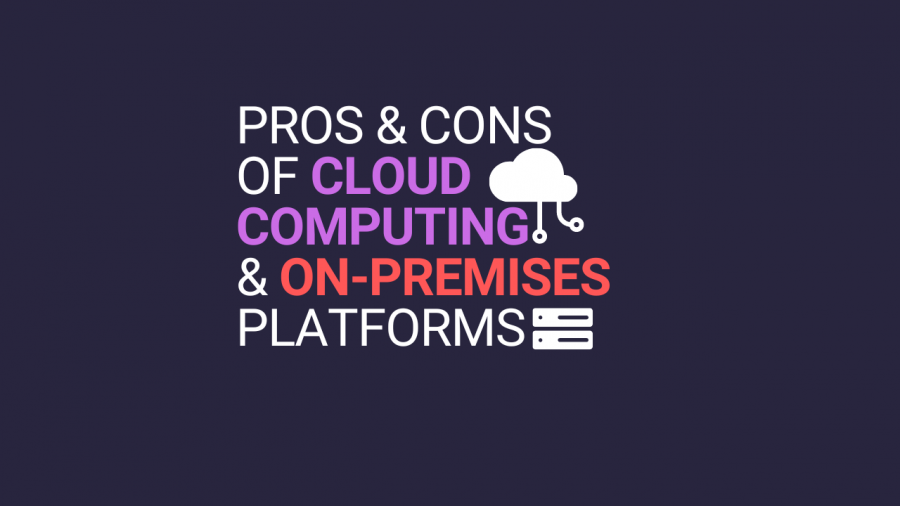
Pros and Cons of Cloud Computing vs On-premises Platforms
If you are planning to build a new business application, it’s important to understand the significance of the app delivery model you choose. Why? This choice will affect not only your business development and future expansion but also possible technological challenges you might face in the event of the wrong choice. Here we go deeper into the differences and pros and cons of cloud computing vs on-premises.
An important note: there isn’t a 100 percent wrong choice, as any option will give you something valuable in terms of delivering your application, whether it’s full data security or solution scalability. It’s more like there can be thoughtfulness and hurried choices that later can eventually backfire on you. Speaking of the choice itself, which of them do you have?
Cutting to the chase, cloud and on-premises computing solutions have heated up the market recently. These are well-known app delivery models, and today, we’re going to scrutinize them, look into the pros and cons of cloud computing vs on-premises and help you better understand which way you should follow.
Pros and Cons of Cloud Computing vs On-Premises
What is cloud computing, and how big is its potential?
Cloud computing is a technology that enables the delivery of hosted services over the Internet, from the provider to end-users. It is based on the sharing of resources to achieve coherence and economies of scale, similar to a public utility. The cloud can be accessed from anywhere with an internet connection, via a web browser or other applications. Cloud computing is sometimes called “cloud storage,” or simply “the cloud,” because all of your files are stored on servers on someone else’s computer.
The idea of cross-platform, location-independent access was an innovative one when cloud computing emerged on the market. However, if we dig deeper, over the years, this technology has surely recommended itself as one of the most desired by businesses. Nevertheless, it has also demonstrated some drawbacks.
Pros and cons of cloud computing
Let’s start with the bright side first. The advantages of cloud computing include:
- Flexibility: Cloud services offer flexibility in terms of deployment options (public, private, or hybrid), scalability, and performance. You can easily scale up or down depending on your needs, with no additional hardware required.
- Scalability: Cloud services are scalable, meaning that you can add resources, such as storage space or processing power, whenever needed without worrying about the costs involved. With this action, as it is usually only charged based on usage levels rather than being charged for all resources required at one time like with traditional on-premises platforms, you don’t have to buy more computers when you get more work because your cloud provider will automatically add resources as needed.
- Pay-as-you-go pricing model: You only pay for what you use, so there’s no need to worry about spending money on unused capacity. This way, cloud computing can reduce costs by eliminating capital expenses, eliminating upfront IT investments, and reducing operational expenses with its pay-as-you-go model.
- Dependability: The infrastructure used in cloud computing is highly dependable due to its redundancy features, which allow for increased uptime and high availability levels. This gives businesses greater peace of mind when using cloud services as their applications will always be available online for them to use without any downtime issues.
- Cross-device accessibility: As long as you have an internet connection, you can access your files from any device, including smartphones and tablets. This makes it easier for employees who work remotely or travel frequently.
The list seems to be pretty impressive, but remember that cloud computing is great only when you wisely use all of these advantages. If you aren’t confident about your skills, contact a software development company, who knows how to develop high-quality cloud-based applications. However, cloud computing isn’t as perfect as its benefits show. What about its drawba
cks?
The list of disadvantages of cloud computing includes:
- Security: Cloud computing is based on sharing resources between different users and applications. This means that all data must be stored in a central location, which can lead to security risks. For example, if one user has access to sensitive information and the system is compromised, then all users’ information will also be exposed.
- Lack of control: If you use cloud computing, you don’t need to worry about hardware or software maintenance because it’s handled by the provider. However, this means that you have less control over how your data is managed and accessed by other users and applications on the platform. This can cause problems if you want to add new features to your application without having to wait for your provider’s approval.
- Disruptions in service: Another concern about using a cloud service is that there are times when services are interrupted or down for maintenance reasons. If you rely on these services for critical work functions, you could find yourself in a bind if there’s an outage at an inconvenient time (like during a deadline). Also, there’s no guarantee that you’ll be able to get back up and running as quickly as possible because maintenance work often takes longer than expected due to unforeseen complications.
- Proprietary software: The software that runs on cloud platforms is usually proprietary, which means it doesn’t come with source code or access to its source code. This makes it hard for developers to customize a product or add new features to their applications. You also won’t be able to see how your data is being stored or managed by the service provider because there’s no transparency involved.
If we analyze whether cloud computing is a beneficial option, then its advantages surely outweigh its disadvantages. However, let’s look into on-premises solutions. Maybe they are even a better option than cloud computing for your business.
Pros and cons of On-Premises

Many companies use the cloud because they don’t want to deal with on-premises solutions anymore. They want to focus more on their core business rather than having to worry about keeping up with their IT infrastructure and managing their own servers or applications.
However, even so, on-premises solutions are still in wide use because of the security and control over data they provide to organizations. With these solutions, companies can maintain control over their own servers and applications so that they can make sure everything is running smoothly at all times without any issues occurring along the way.
If we delve deeper into the on-premises solutions, there are things to rack your brain about before stopping at this model.
Advantages and disadvantages of using on-premises solutions
There are many benefits to using on-premises solutions, among which are:
- Security. Security and control over data remain major concerns for organizations. Even though cloud solutions are more secure than they used to be, some companies still want to keep their data on-premises for better control over security. On-premises solutions also allow businesses to avoid vendor lock-in and ensure that their data won’t be lost if their cloud provider goes out of business or stops offering services.
- Control over data. On-premises solutions give you more control over your data and the ability to store it in any location you choose. You can also integrate your software with existing infrastructure and other applications, including databases. This can be especially useful if the company has multiple offices around the world or works in a regulated industry that requires strong security measures.
- Infrastructure management. It is easier to manage your own IT infrastructure with an on-premises platform. If you want more control over your IT infrastructure or want someone else to do all of the work for you, then using an on-premises platform makes sense, as these platforms are designed specifically for businesses who want to manage their own servers and network equipment without any outside help from an external provider or contractor.
On the other hand, there are some disadvantages to on-premises solutions as well:
- High upfront costs. On-premises solutions often require significant upfront costs for purchasing hardware, software licenses, and installation. These costs can be prohibitive for smaller organizations.
- Maintenance and upgrades. Organizations are responsible for maintaining and upgrading their on-premises solutions, including on-premise storage, which can be time-consuming and require dedicated staff.
- Limited scalability. On-premises solutions are often limited by the capacity of the hardware they are installed on, which can be challenging to scale up or down.
- Limited accessibility. On-premises solutions are often only accessible within an organization’s physical network or through a VPN, making it challenging for remote workers or employees working off-site to access them.
- Lack of flexibility. On-premises solutions can be inflexible, limiting an organization’s ability to customize or integrate them with other systems or applications.
- Limited disaster recovery options. On-premises solutions require organizations to manage their own disaster recovery plans, which can be challenging and expensive to implement effectively. Cloud-based solutions often offer more robust disaster recovery options.
Overall, for the pros and cons of cloud computing vs on-premises: while on-premises solutions can offer greater control and security for organizations, they require significant investments in resources and maintenance, limiting their scalability and flexibility. Cloud-based solutions may be a better fit for organizations that require greater scalability and flexibility but have limited resources for managing their own infrastructure.
Planning on building a communication or social app?
Zangi Communication Solution : App & Desktop
– On-Premises hosted
– Hosted on Zangi Cloud
If you’re planning on making a communication or social media app, Zangi platform stands out with the highest quality of audio and video streaming, fastest encrypted messaging and file transfer, and low bandwidth consumption. All listed are possible thanks to Zangi SCP – new generation data transfer protocol invented by Zangi engineers.
Zangi offers to build business-ready brandable messenger applications on iOS, Android, Desktop and Web to be be set up within 1-2 weeks. White Label setup includes UI branding applying Customers’, logo, splash screen, icons, background, colors, intro text, invite friends text, etc. Or build your own solution with customizations.The server instances can be setup: On the Customer’s servers – on premises hosted or on a rented cloud or on Zangi private cloud cluster, referring to Customer domain URL in all visible queries. Whichever works for your business or community.
Zangi’s value proposition is based on 3 main advantages:
1. Implement your own project idea leveraging Zangi technological advantages, such as the fastest encrypted file transfer in the market, encrypted Audio/Video streaming, low bandwidth usage capabilities etc.
2. Substantially reduce development costs.
3. Substantially reduce your time to market.
Small, Medium & Large Team Chat Software : Get your Secure Team App
So, what’s better for your business?
Pros and Cons of Cloud Computing vs On-Premises: In the end it all comes down to what provides the best return on investment: what technology is right for your business and how it can most effectively meet your needs today, while also allowing you to expand when needed (both in capacity and features).
The decision whether to choose cloud computing or on-premises solutions should be made with care and with regard for your strategic goals and your overall business model. Both on-premises and cloud solutions have their own pros and cons, but many businesses have seen the benefits of combining them to make the most of both options.
Get in Touch
Send us a note using the form below and we will get in touch with you shortly.
Subscribe to Our Newsletter

Leave a Reply